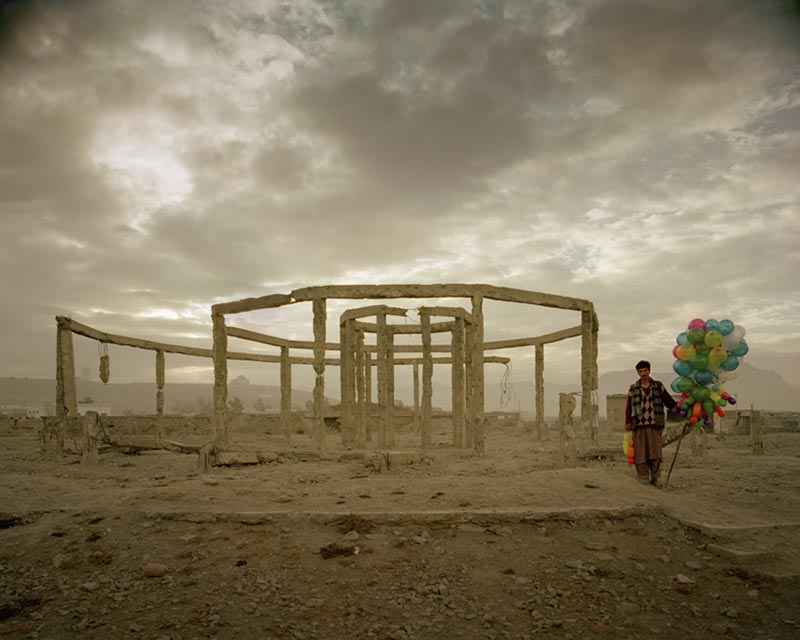
Teahouse, Afghanistan, 2001
Photograph, 24 x 31/8 in.
ABOUT THE ART
This photograph is from a series of images Simon Norfolk created in war-ravaged Afghanistan after the U.S. invasion in 2001. Under a dramatic clouded sky, a lone man stands next to the crumbling outline of what is left of a teahouse. The walls of the building have been reduced to the framing. This implies that the walls were not bombed and flattened, but worn away by the gunfire Afghanistan has endured over twenty-five years of constant warfare. In contrast, the man holds a bright bundle of balloons to sell to children, an activity that was formerly banned during the rule of the oppressive Taliban government. To make this image, Norfolk used an old-fashioned field camera of the kind used by war photographers in the 1800s. It creates images that capture great depth, and helps give his pictures the epic, timeless quality he seeks.
ABOUT THE ARTIST
Simon Norfolk was born in Lagos, Nigeria, in 1963 and now lives in London. From 1990 to 1994 he worked as a photojournalist, covering timely political issues for several progressive publications. His political beliefs and commentary are central to his artwork and drive him to choose his subject matter. In 1994 he began to create landscape images around sites of conflict, war, and genocide, a project that is ongoing. Norfolk states, “I am against all those who through their greed, stupidity, arrogance, narrow-mindedness, blindness, ignorance, or simple ‘couldn’t-give-a-tossness’ are working towards, or are allowing, the world to become more crap.”
AFGHANISTAN
Afghanistan is a mountainous, landlocked country. It is bordered on the north by Turkmenistan, Uzbekistan, Tajikistan, and China. To the west is Iran, and Pakistan lies to the south and east. Afghanistan is a Muslim nation and its population is estimated at over 25 million people. There are several diverse ethnic groups, each with their own language or dialect inhabiting different regions of the country. Differing interpretations of Islamic religion among these diverse groups have fueled decades of internal political disputes and war.
DECADES OF WAR
In 1979 Afghanistan was in the midst of upheaval. Some Afghanis were pushing for a Communist government. Others wanted an Islamic state. The Soviet Union invaded the country to support the Communists. The United States entered the situation, and with the help of Pakistan, provided weapons to the guerrilla fighters opposing the Soviets. After ten years with no progress, the Soviets pulled out in 1989. Warring factions of Afghanis continued fighting one another for control. In 1992 the Islamic rebels gained the upper hand and by 1996 an Islamic rebel group called the Taliban took control. In 2001 the United States invaded Afghanistan in response to the country’s support of al-Qaida terrorists and in retaliation for the 9/11 attacks. The Taliban was overthrown. Conflict remains as warring factions, including the Taliban, continue to challenge the elected government and U.S. and United Nations troops remain in the country. It is estimated that well more than one million civilians have been killed during these decades of war.
THE TALIBAN
When in power, the Taliban imposed harsh laws based on their narrow understanding of Islam. Television and non-Taliban music were banned. Kites, balloons, soccer, and some games were illegal. Taliban human-rights abuses shocked much of the world. Men were forced to grow beards of an exact length or risk prison. Women had most of their rights taken away. Under the Taliban, all women were denied education, jobs, and health care, and were forced to completely cover themselves by wearing a burka. If these rules were not obeyed to satisfaction, one was stoned or whipped to death. Taliban fighters still gather in various areas of the country.